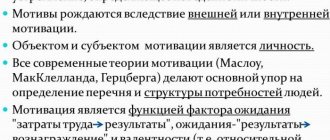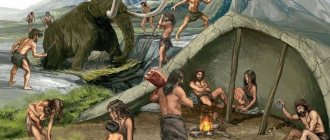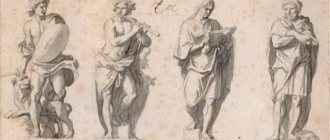Main types of human activities
Activity is the process of transforming the surrounding reality. A person can try to change material things, nature, society, himself in order to satisfy his needs.
It consists of several elements:
- Subject (performs actions).
- Object (what actions are aimed at).
- Motive (encourages action).
- Goal (expected result).
- Means (what they use).
- Process (order of actions).
- Outcome (result).
There are different types of human activity depending on the goals, the object to which the action is directed, and the result. But this division is conditional. The same concrete action can be material and spiritual.
For example, printing books not only creates physical paper copies. Works are written, edited and read, that is, mental work occurs.
Target
When internal motivation takes place, we begin to build an image in our head of what we want to achieve in the end. A girl who wants to get married begins to think about what her future husband should be like: age, eye color, social status, nationality, appearance, etc. Thus, she paints for herself a clear picture of what she actually needs to strive for.
Goal setting is an integral part of human activity.
We first create something in our minds, then we try to bring it to life. Animals, unlike us, are guided only by instincts: they do not think about what, how and why they do something. When choosing a female, a wolf does not walk through the forest for 3 years looking for a she-wolf with the most beautiful fur, but a person is quite capable of this.
Maybe this is our happiness - we can choose and adjust our goals.
Practical activities
This variety is aimed at creating or changing material things and the environment. Man produces certain objects, changes their appearance or properties, and influences nature.
This includes:
- sewing clothes;
- creation of equipment at the plant;
- deforestation;
- construction of houses.
That is, all material goods and everything that exists on the planet thanks to society.
Education
This is another important type of human activity. The social studies topic devoted to activity is interesting because it examines its various types and allows us to consider the whole variety of types of human activity. Despite the fact that the human learning process begins in the womb, at a certain period of time this type of activity becomes purposeful.
For example, in the 50s of the last century, children began to be taught at the age of 7-8 years; in the 90s, mass education was introduced in schools from the age of six. However, even before the start of targeted learning, the child absorbs a huge amount of information from the world around him. The great Russian writer L.N. Tolstoy emphasized that at the age of 5 years a small person learns much more than in the rest of his life. Of course, one can argue with this statement, but there is a fair amount of truth in it.
Spiritual activity
She strives to change the inner world, thinking, consciousness of both one person and society. Views of the world, understanding of good and evil, and awareness of one’s goals are formed.
This includes the scientific, creative, religious spheres of life, that is, everything that is directed inside a person, and not at the outside world. This could be learning something new, painting a picture, reading a prayer.
Leading activities: play, communication and work
Also among the types of activities are play, communication, and work. During the game, actions are performed using imaginary means. It is the process that matters, not the result. Play can be both entertainment and a way to explore the world.
The transfer of information through interaction is called communication. It is needed to exchange news or important information, as well as to improve your emotional state.
Labor is aimed at creating material or spiritual benefits that will be useful to people. It can be physical, mental or a mixture, such as sewing clothes.
Ways to improve work efficiency
The result of the enterprise’s activities depends not only on increasing the number of employees and improving the material and technical base, but also on improving the skills of existing employees. This is achieved through in-house training. Such training, in essence, is the body’s adaptation to new psychophysiological functions that the employee must subsequently perform.
To achieve the goal of work, the employee needs rest. One of the most effective ways to improve the quality of staff performance is to optimize work and rest schedules. As a rule, the change between work and rest must be observed at certain periods of time, namely during:
- work shift (break)}
- days (standard working day)}
- weeks (weekends)}
- year (vacation).
The specific time allocated for rest depends on the conditions in which the employee works, as well as on the terms of the employment contract. This applies to both short-term breaks (during the working day) and long-term ones (during the year). Thus, for most professions, the norm for short-term rest is 5-10 minutes. In one hour. Thanks to this break, you can restore the psychophysiological functions of the body, as well as relieve tension.
Types of human professional activity
When a person performs his duties at work, it is considered a professional activity. It has standards, goals, predictable results. The employee receives specific knowledge and skills to become a representative of the profession.
| View | Description | Example |
| Man-technique | Working with mechanisms | Car mechanic, welder, plumber |
| Man-man | Interaction with others, communication | Teacher, journalist, waiter |
| Man-nature | Working with plants or animals | Veterinarian, biologist, gardener |
| Sign Man | Processing numbers or symbols | Accountant, translator, engineer |
| Man-artistic image | Making art | Artist, actor, musician |
Services sector
All three areas of activity mentioned below are combined into one group, which is called the service sector. In themselves, they are not human economic activity as such, but contribute to its active development.
The science
Science in the state is a fundamental part that allows regulating not only processes within the country, but also providing the country with innovative technologies, providing the most advanced developments, discoveries, and facts. Science includes all possible areas of human activity.
In its essence, science is a certain set of knowledge in a specific environment, which is characterized by a wide range of concepts, terms, and patterns. Thanks to scientific discoveries, any country can take a leading position in the world rankings. Science helps the state develop.
Education
Education is the state’s guarantee for a bright future. Time flows mercilessly forward, and with it the years of life. The old generation is being replaced by a new one. But in order for it to ensure a decent existence and development for itself, its family and the Motherland, it is necessary to teach young people how to do this correctly, how to correctly assess the situation. Education in the Russian Federation consists of three main stages:
Each stage is divided into several stages, and they, in turn, are characterized by a certain set of knowledge and skills. Only after receiving a sufficient level of knowledge will a person be able to apply it in his life and engage in a specific type of economic activity.
Rice. 4. Service workers
Arts and culture
Art has always played a significant role in the development of the country. It was this that helped not only to sensibly assess the situation, but also to compare reality with fantasy. Art is a fairly broad concept that includes such areas as painting and literature. Providing spiritual good is the true goal pursued by culture. Cultural wealth, heritage is something that will never be forgotten. It has been preserved for many thousands of years, passed down from generation to generation. Traditions are what a nation values, which shows not only customs, but also the moral state of each person. For every citizen, culture is part of the soul. It is impossible not to take part in industrial activity - perhaps not to take part in cultural development.
Reactionary activity
Such actions have a negative result, which led to decline. This effect is assessed on a historical scale. Therefore, sometimes the same action can belong to different types at different times.
Examples include the beginning of World War II or the introduction of the oprichnina. These events led to large-scale negative consequences.
Transport industry
The transport economy or transport system is a means of communication between industry and agriculture, as well as between other activities. In order to ensure the exchange of products between different directions, transport is needed that will solve this problem. In addition, transport activities allow people to move to different parts of the country or the world. Today there are several types of transport:
- Zheleznodorozhny
. Includes all trains, locomotives, trains, subways. It is the safest means of transportation and has a high efficiency factor. - Automotive
- these are cars of various classes - trucks, cars, special ones. - Air
means airplanes and helicopters. - Water
- it consists of ships, barges, boats, boats.
Rice. 3. Mozhaisk interchange of the Moscow Ring Road
Material activity
Associated with changes in real objects of the surrounding world that can be seen or felt. The results have meaning for one person or a large group of people.
This includes:
- agriculture;
- production of parts in factories;
- cooking.
Creativity also has a material side, as artists can create paintings or sculptures.










